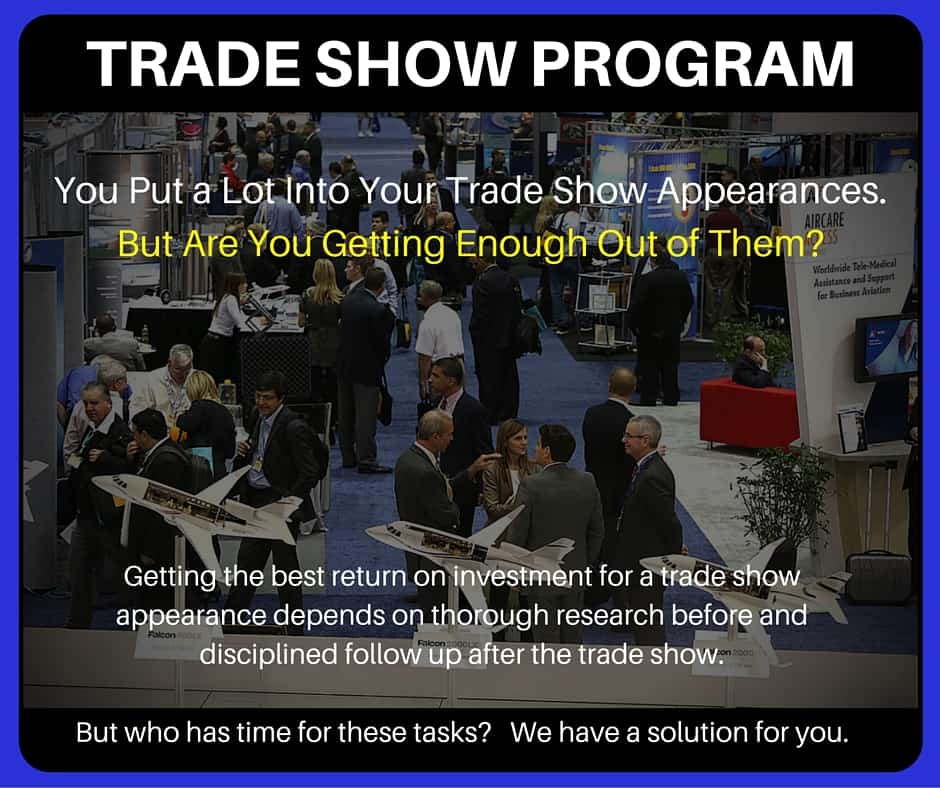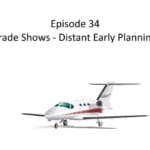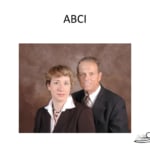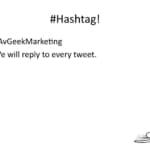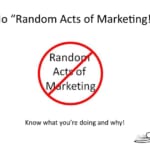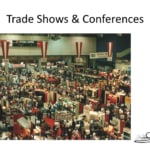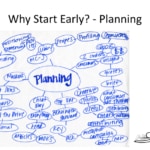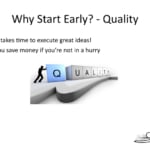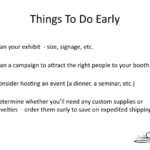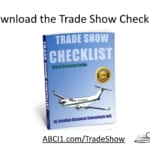Trade shows are a huge, and very powerful part of the marketing plans for MANY aviation companies. And most people agree that early planning is important. But what exactly should you be DOING early, and why?
Transcript – Trade Shows- Distant Early Planning
Paula Williams: Welcome to aviation marketing Hangar Flying, episode number 34. Trade Shows, Distant Early Planning. Remember the distant early warning system?
John Williams: Right [LAUGH]
Paula Williams: [LAUGH] Exactly, most people don’t start soon enough. So I’m Paula Williams.
John Williams: And I’m John Williams and it’s early in the morning.
Paula Williams: And we are ABCI and ABCI’s mission is?
John Williams: To help you ladies and gentlemen out there in the aviation world out there sell more products and services.
Paula Williams: Absolutely, so if you’d like to join the conversation about this webinar or any of our webinars or any of our other materials, we’re using the hashtag #AvGeekMarketing.
#AvGeekMarketing and we promise we will reply to every tweet or every Instagram or every other thing that you’re using and you can send comments, questions, anything else that you’d like to discuss. So our motto is no random acts of marketing and a lot of what people do at trade shows looks a lot to us like random acts of marketing right John?
John Williams: Not only looks like it, some of it doesn’t even look relative to the product.
Paula Williams: Exactly. I think what happens a lot is that a salesperson for the trade show will call and talk to somebody and tell them about this fabulous trade show and give them a deal or something like that on booth space.
And someone will decide sure it’s not too far away and it’s convenient for us let’s just do it. Without giving a whole lot of thought as to how this fits into their grand scheme of things. What their purpose is in really doing trade show, how they’re gonna measure their return on investment, all of those other kinds of things.
So what we’re gonna talk about today are some of the things that we want to do to make sure that your trade show is not a random act of marketing and that you actually do get a return on investment out of it. Now trade shows in the aviation industry are hugely important, they’re one of the biggest traditional methods of advertising a product or service and it is a really great way to meet a lot of people in the same place, right John?
John Williams: Yeah. If you haven’t been to one, particularly NVAA or even the regional, it’s quite an event.
Paula Williams: Right, the term that comes to mind is dizzying just because of the number of people that are there both as exhibitors and attendees. It can be really overwhelming, and it can be a really fantastic opportunity.
But, it can also be a complete waste of time and money, and very, very frustrating, and a lot of people. In fact, we were reading Steve Miller’s book, How to Get the Most out of Trade Shows, and in the preface he talks about how much he hates trade shows or how much he used to hate trade shows.
And simply because you’re surrounded by people you don’t know, a lot of it is very disorganized, a lot of it is chance as far as meetings and other kinds of things. But there’s a lot of ways to make that a lot better, for you and for your salespeople, where you can really set yourself up for success, instead of just being thrown into, the meat grinders, they say, right?
John Williams: Yes, that’s correct.
Paula Williams: Right. So, today we’re talking about starting early, and what you can do, in terms of planning. But why [LAUGH] is it important to start early? We got lots of other things on our plate and if we’ve got six months to get to a trade show, like right now when we’re recording this it’s June.
NVAA the big trade show of the year is in November, so you know why should we start thinking about this now?
John Williams: Because there’s a lot to do between now and then if you’re going to do this right and get any kind of ROI.
Paula Williams: Exactly, so it takes time to execute great ideas, and to come up with really good campaigns.
Creative work doesn’t do very well, I know this is a point of contention among some people, some people think that creativity just springs out of your head when you need it the most. But for me, I prefer to have a lot of time, especially if I’m trying to think up something really, really cool.
Or think up something that nobody else is doing or something that’s really creative. I do best with that when I’m not under pressure, and so if you can start early it takes the pressure off and you can actually be a lot more creative and a lot more options that things you can do.
And the other thing is you save money when you are not in a hurry, right John?
John Williams: Typically.
Paula Williams: Being the CFO?
John Williams: [LAUGH] Well, can always get better deals on everything from airline tickets to hotel rooms if you plan way in advance.
Paula Williams: Absolutely. And that’s true of printing, and any novelties that you need to buy, and anything else.
You’re not paying expedite fees or expedite shipping fees, or any of those kinds of things. So, you save a lot of money, and you can do a lot more, get a lot more bang for your buck if you’re not doing the last minute sort of things. So a lot of people have the problem of okay well that’s great, I love to start early what the heck am I supposed to do?
John Williams: And that’s the other thing.
Paula Williams: Right, so-
John Williams: We can help you with that.
Paula Williams: We can help you with that, exactly. So what we like to do, especially when we have a really large project is to monopolize a wall, and we’ve done this in a lot of different places that we’ve worked.
And John and I have actually worked together before we were in aviation marketing, we were working for a financial services company, and we were doing really big projects that involved hundreds of people. I don’t know if we were doing one that was thousands of people.
John Williams: Close.
Paula Williams: Close, probably to a thousand but when you have projects that are really really big, it is very reassuring to have a lot of space that’s very visible so we would monopolize a wall in a conference room.
And that would be our planning stage that everybody could see. And we’d write down questions, we would write down calendars, we’d write down tasks, dependencies, anything that we could think of and anything that anybody else could think of. They were welcome to put a sticky note on the wall, and then, of course, we review that on a regular basis and figure out what needs to go where, and organize that.
So, a lot of us are working virtually these days, we’re not in an office with a conference room, or a big, white board. But, when we’re home we still like to do that. I have a whiteboard in my office, and John has a whiteboard in his office. And our big projects get a really big square on one or the other of our whiteboards so that we have a place to plan that and think about it.
And every time we look at it we think, you know what we should do? Here’s a really great idea and here’s something that maybe ties into that other idea. And the more you see that and the more you add to it, the better those plans become because you’re, it’s working in your subconscious as you’re going throughout your day.
And just occasionally glancing at that wall right John?
John Williams: Absolutely.
Paula Williams: And the other things is, if your who team can see it, they’re gonna think of things you wouldn’t think of. Maybe the people in charge of shipping are going to say, you know what, this is going to take longer than you have written out for it here, so let’s make a change to that.
Or they may have a really great idea that springboards off of something that’s already on the wall. So those are our reasons to make this really visible. So the other reason is quality. It takes time to execute really good ideas. So if you want to create a really great brochure or a really great product demonstration or something like that.
You can take the time to write that out, rehearse it, show it to people, see what they think, refine it, do it again, do it again, do it again. Sales pitches and some of the best sales presentations that we have ever heard our from people who have been doing it on consistent basis and refining that for years.
And so if you have a couple of months to refine your presentation for a trade show, you can really get that down, get that comfortable. Get to the point where you can do it with out even thinking about it. Then you can adapt it really well to whomever you’re talking to.
Because your stuff is embedded in your head having done it so often, right John?
John Williams: Yep.
Paula Williams: Like have you ever had a project, for anything where you had a long enough time to work on it that you really got it polished? Tell us about that?
John Williams: Well, there are a couple of projects, the one, I don’t what you mean by a long time.
I’ve done one that was pretty quick, but some of the ones that take longer, we’ve had months to plan. And those really work out well. And matter of fact, the trade shows we did for NBAA for us we do six or eight months in advance.
Paula Williams: Great.
John Williams: And it looks like we live and breathe the stuff if we go down there.
Paula Williams: [LAUGH] Right. And we actually have worked in a mastermind group with a magician. His name is Dave D and he works for GKIC and he talks about his programs. He used to be a, and he still is, a magician. But he uses magic in a lot of his presentations and things like that and how would it be to be a sales guy who’s also a musician?
That can be really useful. But he will tell you that the whole secret of magic, especially of sleight of hand or anything that’s like a presentation kind of a magic is practice, and time. You don’t just wake up one morning and decide to do a particular trick. People who are in the profession of doing magic, typically, it takes them months, before they will perform a particular trick before the public.
And, the reason is because it takes that long to number one get the mechanics down, and then second to get it smooth enough. And then third, to do whatever you’re doing on top of that to distract people, while you’re doing the trick. So, you have to get the muscle memory, you have to get the stuff in your head, you have to get the engagement with the audience, you have to get all of that down, and all of those layers don’t just happen at one time.
I think people often expect too much of themselves and they just think well I’ll just wing it when I get there and that just is not going to come across as polished. It’s not gonna come across as really well done. So that’s true of your sales presentation, that’s true of you product demonstrations, that’s true of the way you put your booth together.
That’s true of just about everything there is to know about trade shows, and quality really shines through. You can tell the people that it’ll just band it together versus the people who really have their stuff down, right?
John Williams: It occurs to me that the more money that you’re going to put up and the more people involved, the more advanced you need to start planning.
Paula Williams: Right.
John Williams: I mean, the project we did with several hundred people, I believe we started almost two years in advance to make that one work.
Paula Williams: Right. And typically when you’re doing a trade show, it involves more than just you. You may have a team of three or five or 12 or 20 depending on the set size of your company.
But, it does involve more than just one person. So the more people you add exponentially, the more time you need to get everybody’s ideas and get everybody onboard and get everybody’s input to make sure they’ve got their practice done and, all of that stuff.
John Williams: Well, they need to really understand how they fit into the process and they’ve got to practice with other people in some cases.
Paula Williams: Right, exactly. So another reason to start early is your review cycle. We talked about how it takes time to execute great ideas, and you save money when you’re not in a hurry. Review cycles are something we cannot emphasize enough. We are in the business of producing marketing materials for clients.
And the earlier we can get a draft to clients, the better final product we’re gonna end up with because often it will spark ideas on their side. We really shouldn’t be saying this. We should be taking it from this other angle, or, here’s an error that I didn’t catch.
Now we have time to do the reset and make it really polished and work out. So you really want to have a very simple review cycle. And ours, of course, is we draft something and circulate it among ABCIs team. We publish it to base camp with a cover sheet.
And the client has revisions, it’s approved, we approve it, we do a final review, and then publish it to the appropriate channels. Or, most often, especially on a first draft, the client has some things they want to discuss, we make revisions. We set up a different file name with a different date, put it back into base camp, re-draft it, circulate it among ABCI’s team, and go through that loop as many times as we need to to get something perfect.
And there is a difference between a document that has been perfected, and a document that’s been thrown together, and they’re just 1,000 times more effective. People may not notice on the surface, but there is a subconscious acknowledgement I think of when you’re reading something that has been thoroughly reviewed versus if you’re reading something that’s been slammed together, right?
John Williams: [LAUGH] Yes, it comes through to anybody that reads.
Paula Williams: Yeah, and even if they say they don’t care, they just want a rough draft [LAUGH].
John Williams: They do care.
Paula Williams: They do care. And it will affect the way that they feel about the contents of the document.
So if you put together a really great polished fabulous brochure, it’s gonna be much more effective than something that you throw together at the last minute.
John Williams: As a matter of fact, I don’t know why they say they don’t care, because every time I’ve run across that, they do care.
Paula Williams: Exactly, I’ve run across that a lot. Especially lately people will say just put something together for me. I don’t care if it’s perfect I just want to see something, that makes me crazy [LAUGH].
John Williams: Well and then if you, obviously you can’t put it together perfect to start with but you have to do your best, and they have to know it’s an interview process.
Paula Williams: Exactly. And we’ve already talked about this before, but I think it bears a little bit more discussion. The financial end of the situation, the more time you have, the better you are able to put numbers in boxes. And John’s really good at this, the more time you give him with something that needs to be paid for, the more options he has as far as using cash flow from different situations, using other financial resources maybe bartering or trading with other organizations.
There are lots of ways to make the financial situation work better if you have more time. If you’re at the last minute you have no choice but to just shell out the cash, and you absolutely need to have a hotel room in a certain city, on a certain night and it’s the night before, you really don’t have much choice.
You just have to do what you gotta do.
John Williams: That was true even when I planned out our vacation. I started eight months in advance and I got airline tickets for about, what was it, $370 total round trip.
Paula Williams: To Hawaii, that’s crazy. Everybody’s asking, how did you do that?
Well-
John Williams: You plan ahead of time. Eight months, you can put alerts out there and everybody will come back and say they got this or that. So you just have to grab one and be ready. We got our hotel room for $100 a night in Hawaii. It was, again, planning in advance gives you lots of time to stare up options.
Paula Williams: Yeah, and this was not a bargain basement sort of situation, it was actually a really really nice hotel, you just have a lot more options with a lot less money if you start earlier. And so fair watchers are a good one, thinking out of the box in terms of the financial impact of a situation.
Or maybe there’s a company that does, something that you need done or maybe you can do some partnerships with people who are also going to the trade show. Where you can save some money on some of the talent or shipping or other things that you need done.
John Williams: I mean we’ve had reservations at NBAA for hotels now for a month or so and this is now just May, or June.
Paula Williams: It just started being June. [LAUGH] Exactly. So, yeah, it’s really financially to your advantage to start early. So what are some of the things you can do early? The earliest one, of course, is to attend the show the year before you decide to exhibit, and walk around, see who’s there.
See what kinds of booths there are, see if you’re looking at maybe a ten by ten, see if they’re stuck off in a corner somewhere. And they’re giving all the attention to the big guys with the big booths, you want to see where the traffic flows are. Where do people go when they first come in in the morning, where do they go at lunch?
Study those traffic flows and figure out where do you want your route. Because it’s not gonna cost you anymore usually for better placement in the show. Also, you may decide the show is not for you and that would save you a lot of money by not doing the wrong shows.
So, you want to look at a lot of different things there. You’re gonna take notes of opportunities for visitors, maybe they have a product spotlight. A lot of places will also have a press room. So you wanna take notes of all of the different things you could do so you can maximize your investment in that show.
You wanna research your top ten most feared competitors and your top ten most wanted customers, and find out if they are there. And if they’re there, what size of booth do they have? Are they doing a product demonstration? Are they doing something really cool? Do they have booth talent?
Do they have a magician? What do they have that you want to make sure that you’re going to be different from, right? [LAUGH] All kinds of things. You want to obtain the show’s schedule and other information as soon as you possibly can so that you can start planning out those days.
Which days do you want to focus on different activities, and things like that. And note important deadlines, so if you know there is a deadline to get your press releases in. If there is a deadline to reserve your space and get the premium spaces, other kinds of things, to get the most out of the show.
John Williams: And you should take note of how to contact the folks that put out those daily rags there as well.
Paula Williams: Yes, a lot of the shows have, especially NBAA, has the, I think, two different dailies, news dailies that come out. They have young ladies distributing those at the entry point to the convention center and things like that.
Those guys work pretty hard to fill that space, and they love photos, charts, graphs, other kinds of things. So, if you can find a way to do something newsworthy and get a photo in one of those rags, we call them rags, we mean that in the nicest possible way.
They’re actually fairly polished news dailies, but you do want to look at those things and figure out how can you use this opportunity to your best advantage. All right, some other things to do early, plan your exhibit. What size do you want, how do you want your signage to stand out from everybody else that’s gonna be at the show?
We always advise people to go up, go vertical, as vertical as you possibly can, because then people can see it from farther away. And also most people don’t go much above, they usually have those curtains that go between the booths that are about six, seven feet tall depending on the show.
John Williams: The best one I’ve seen was at LA expo and a company who I’ll go ahead and name.
Paula Williams: Go right ahead.
John Williams: LA Values.
Paula Williams: Yup.
John Williams: Put their name on the size that tell you the numbers of the rows that are way up high.
Paula Williams: Yeah.
John Williams: So it would say, you walk down the roads and he’s always looking up. Cuz you’re looking for a specific booth number. You look up high and it says 2020 to 2050. And underneath those numbers they’ve just extended the sign and put their logo up there and their name.
It was everywhere.
Paula Williams: Brilliant, yeah.
John Williams: That was, that was outstanding.
Paula Williams: So kudos to LA Values on a great idea. But generally speaking when you walk into one of those convention centers, it’s really overwhelming. And so what you tend to do is look up because that’s where they have the row numbers and the booth numbers and things like that.
So when you’re looking up, to kind of orient yourself, the first things that you see are the things that are the tallest. And so if you can suspend something from the ceiling, sometimes they allow that at different shows, have signage and other things that are suspended and rotating.
Or if you can’t do that, at least have tall banners and other signs that stick up above all the rest of the fray in the convention center. So think vertical, especially when your planning your exhibit and your signage. Look at the guidelines of course, for the show, and make sure that it’s not gonna get disallowed.
But as tall as they will allow, that’s really where you want your best visual stuff to go. You wanna plan a campaign to attract the right people to your booth. So think about what you can you invite people to do at your booth. Can you invite them for a mini consultation or product demonstration?
Or a contest or game of some kind, the earlier you start thinking about that the better ideas you’re going to come up with. You want to think about the kind of people you want to come to your booth. What can you do that will make them spend 20 minutes out of this very valuable time that they have at the show to make it a point to come to your booth?
It has to be something other than just come see us.
John Williams: Or give away an iPad, you don’t do that to everybody.
Paula Williams: [LAUGH] Right, exactly. Okay, another thing you might want to do is consider hosting an event, or a dinner, or a seminar, or something like that.
And this is whether or not you’re exhibiting a trade show. Some people just show up in the same town at the same time, stay at a nearby hotel, and host a seminar or a dinner. Because they’re taking advantage of the fact that everybody’s in town for this particular trade show.
John Williams: As a matter of fact, we attended a few of those dinners at various trade shows.
Paula Williams: Exactly. Or you know a seminar on a particular topic. The problem there is that there’s a lot of competition for people’s time, especially at dinner. And a lot of the fuel companies and other folks that are fairly large companies with a lot of resources do some big parties at night during the show.
So you may want to do a breakfast, you may want to do something the day before or the day after the show, while people are in town. But you have to consider that there is a lot of demands on people’s attention, and make sure you get RSVPd so you don’t end up with an empty room.
All right, another thing you want to do is determine whether you’ll need any custom supplies or novelties. And you want to order them early, because a lot of the novelty companies will give you a better price and you’re in a much better negotiation position, especially if you’re ordering a lot of stuff, if you give people more time.
John Williams: Not only that, if they make a mistake and you don’t see it, ’til you get the product to look at, you have a chance to tell them to fix it.
Paula Williams: Right, and we are really particular about novelties and other kinds of things, and a lot of them end up being really, really cheap and or badly done.
We send a lot of them back and make them redo them, or we end up cancelling the order and ordering something else. So you want to make sure that those are guaranteed, and make sure that you get them early enough to try them out. If you get pens or whatever, pick some random ones out of the bundle and make sure that they actually write.
If you’re getting lights make sure that they light, if you’re getting other supplies, make sure that they don’t seem overly plastic, or overly cheap. And if they are and if they don’t represent you well, don’t use them, make sure that you have a guarantee, so you can send those back and get something else.
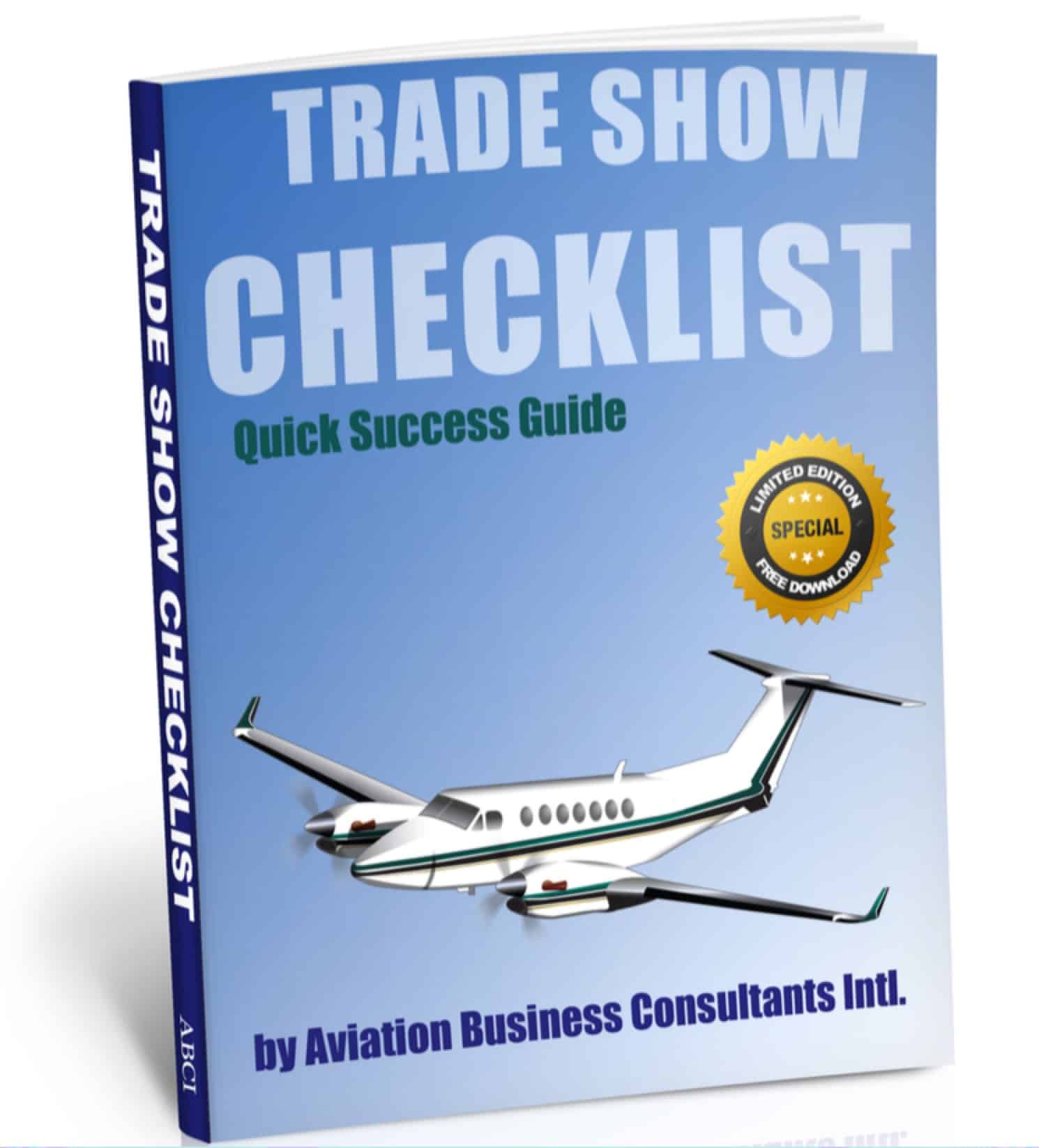 All right, and if you start that a few months ahead of time you can do that a couple of times if you need to. And say, you know what? We’re not gonna do this. We’re gonna do something completely different. Start over, back to the drawing board. All right, so if you have not already downloaded our trade show checklist, you can get that fairly easily at ABCI1.com/TradeShow.
All right, and if you start that a few months ahead of time you can do that a couple of times if you need to. And say, you know what? We’re not gonna do this. We’re gonna do something completely different. Start over, back to the drawing board. All right, so if you have not already downloaded our trade show checklist, you can get that fairly easily at ABCI1.com/TradeShow.
It’s Alpha Bravo Charlie India number one dot com forward slash TradeShow, ABCI1.com/Tradeshow. all one word. So download that, it has all of this information and a lot more detail that you can go through and check things off as you do them. You can hang up some of those pages on that white board we talked about, and make sure those things get done.
So go sell more stuff.
John Williams: Yup.
Paula Williams: America needs the business.
John Williams: Zig Ziglar.
Paula Williams: Exactly. And subscribe to our podcast, aviation marketing Hangar Flying. We are on iTunes, Stitcher, and Google Play. Please do subscribe and please do leave a rating. We’ll see you next week.
John Williams: See you next time.
Download our Trade Show Checklist here:
Need more help? Get our consultants to do the work with you with our Trade Show Program
